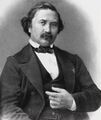Template:Selected anniversaries/August 13: Difference between revisions
No edit summary |
No edit summary |
||
| Line 1: | Line 1: | ||
<gallery> | <gallery> | ||
||1521 | ||1521: After an extended siege, forces led by Spanish conquistador Hernán Cortés capture Tlatoani Cuauhtémoc and conquer the Aztec capital of Tenochtitlan. | ||
File:Rasmus_Bartholin.jpg|link=Rasmus Bartholin (nonfiction)|1625: Physician, mathematician, and physicist [[Rasmus Bartholin (nonfiction)|Rasmus Bartholin]] born. He will discover the double refraction of a light ray by Iceland spar, publishing an accurate description of the phenomenon in 1669. | File:Rasmus_Bartholin.jpg|link=Rasmus Bartholin (nonfiction)|1625: Physician, mathematician, and physicist [[Rasmus Bartholin (nonfiction)|Rasmus Bartholin]] born. He will discover the double refraction of a light ray by Iceland spar, publishing an accurate description of the phenomenon in 1669. | ||
||1756 | ||1756: James Gillray born ... caricaturist and printmaker. | ||
||Henri-Louis Duhamel du Monceau | ||1782: Henri-Louis Duhamel du Monceau dies ... physician, naval engineer and botanist. | ||
||1814 | ||1814: Anders Jonas Ångström born ... physicist and astronomer. | ||
||1819 | ||1819: Sir George Stokes, 1st Baronet born ... mathematician and physicist. | ||
||Heinrich Louis d'Arrest | ||1822: Heinrich Louis d'Arrest ... astronomer | ||
||1826 | ||1826: René Laennec dies ... physician, invented the stethoscope. | ||
||1831 | ||1831: Nat Turner witnesses a solar eclipse which caused the sky to appear a blue-green color, which he envisioned as a black man's hand reaching over the sun. Eight days later he and 70 other slaves kill between 55-65 whites in Southampton County, Virginia. | ||
||Herbert Hall Turner | ||1844: Johann Friedrich Miescher born ... biochemist and biologist who studied cell metabolism and discovered nucleic acids. In 1869, while working under Ernst Hoppe-Seyler at the University of Tübingen, Miescher investigated a substance containing both phosphorus and nitrogen in the nuclei of white blood cells found in pus. The substance, first named nuclein because it seemed to come from cell nuclei, became known as nucleic acid after 1874, when Miescher separated it into a protein and an acid molecule. It is now known as deoxyribonucleic acid (DNA). Pic. | ||
||1861: Herbert Hall Turner born ... astronomer and seismologist. | |||
File:Eugène Delacroix.jpg|link=Eugène Delacroix (nonfiction)|1863: Artist [[Eugène Delacroix (nonfiction)|Eugène Delacroix]] dies. His use of expressive brushstrokes and his study of the optical effects of color will shape the work of the Impressionists. | File:Eugène Delacroix.jpg|link=Eugène Delacroix (nonfiction)|1863: Artist [[Eugène Delacroix (nonfiction)|Eugène Delacroix]] dies. His use of expressive brushstrokes and his study of the optical effects of color will shape the work of the Impressionists. | ||
Revision as of 15:07, 19 August 2018
1625: Physician, mathematician, and physicist Rasmus Bartholin born. He will discover the double refraction of a light ray by Iceland spar, publishing an accurate description of the phenomenon in 1669.
1863: Artist Eugène Delacroix dies. His use of expressive brushstrokes and his study of the optical effects of color will shape the work of the Impressionists.
1899: Mathematician, economist, and crime-fighter Joseph Louis François Bertrand publishes new class of Gnomon algorithm functions which predict and prevent economic crimes against mathematical constants.
1903: Physicist and mathematician Sir George Stokes, 1st Baronet born. He will make seminal contributions to fluid dynamics (including the Navier–Stokes equations) and to physical optics.
1941: Film director and arms dealer Egon Rhodomunde raises money for new film by selling shares in the Manhattan Project.
1942: Major General Eugene Reybold of the U.S. Army Corps of Engineers authorizes the construction of facilities that would house the "Development of Substitute Materials" project, better known as the Manhattan Project.
2017: Time-travelling physician-warrior Asclepius Myrmidon discovers unregistered halting problem, predicts emergence of crimes against mathematical constants.






